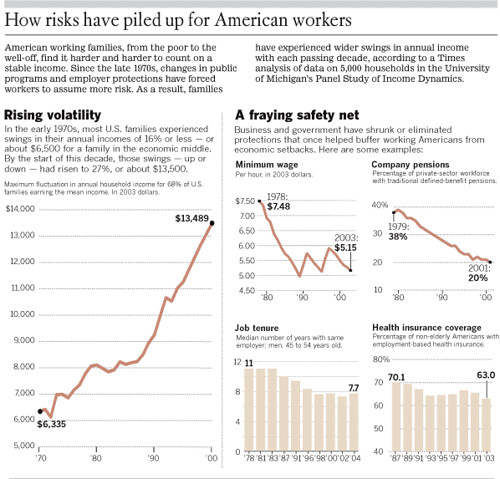Increasing Risk
I recently had a discussion with a family friend who is rather conservative, and a little esprit de l'escalier prompts me to make the following comment. I more or less said this to my interlocutor, but I wish I'd had the evidence and graphics at hand. So here it is now, for what it's worth.
Anyway, the discussion was one of those "good ol' days" comparisons to the present, and the difference being emphasized did not seem to capture the truly distinctive feature of our situation. I think it is the increasing risk that people are living with now. It is true that we have devised numerous ways to minimize and soften the risks to health and livelihood and that life in the 1920s was plenty risky, but many of those safety nets devised to overcome the problems of that era are disappearing. For example, pension plans are no longer reliable; many employers no longer offer benefits for their employees; minimum wage is stagnating; job-security is diminishing; and Americans experience larger and more sudden downturns in their income.
This chart from the LA Times sums up the statistics involved here:

All of this is not to say that the good ol' days were superior in every respect, but that what was superior was not just the old-fashioned values and so forth. In fact, government programs such as Social Security (as well as the others which aid the poor and sick in our society and work for the common good, e.g., the Surgeon General, the Environmental Protection Agency, Housing and Urban Development, Health and Human Services, Education, etc.) reflect a moral improvement (or, at least, an improved application of an abiding moral sentiment). What we are seeing recently, however, is a moral lapse, but not one related to personal morality so much as social justice.
Anyway, the discussion was one of those "good ol' days" comparisons to the present, and the difference being emphasized did not seem to capture the truly distinctive feature of our situation. I think it is the increasing risk that people are living with now. It is true that we have devised numerous ways to minimize and soften the risks to health and livelihood and that life in the 1920s was plenty risky, but many of those safety nets devised to overcome the problems of that era are disappearing. For example, pension plans are no longer reliable; many employers no longer offer benefits for their employees; minimum wage is stagnating; job-security is diminishing; and Americans experience larger and more sudden downturns in their income.
This chart from the LA Times sums up the statistics involved here:

All of this is not to say that the good ol' days were superior in every respect, but that what was superior was not just the old-fashioned values and so forth. In fact, government programs such as Social Security (as well as the others which aid the poor and sick in our society and work for the common good, e.g., the Surgeon General, the Environmental Protection Agency, Housing and Urban Development, Health and Human Services, Education, etc.) reflect a moral improvement (or, at least, an improved application of an abiding moral sentiment). What we are seeing recently, however, is a moral lapse, but not one related to personal morality so much as social justice.

0 Comments:
Post a Comment
<< Home